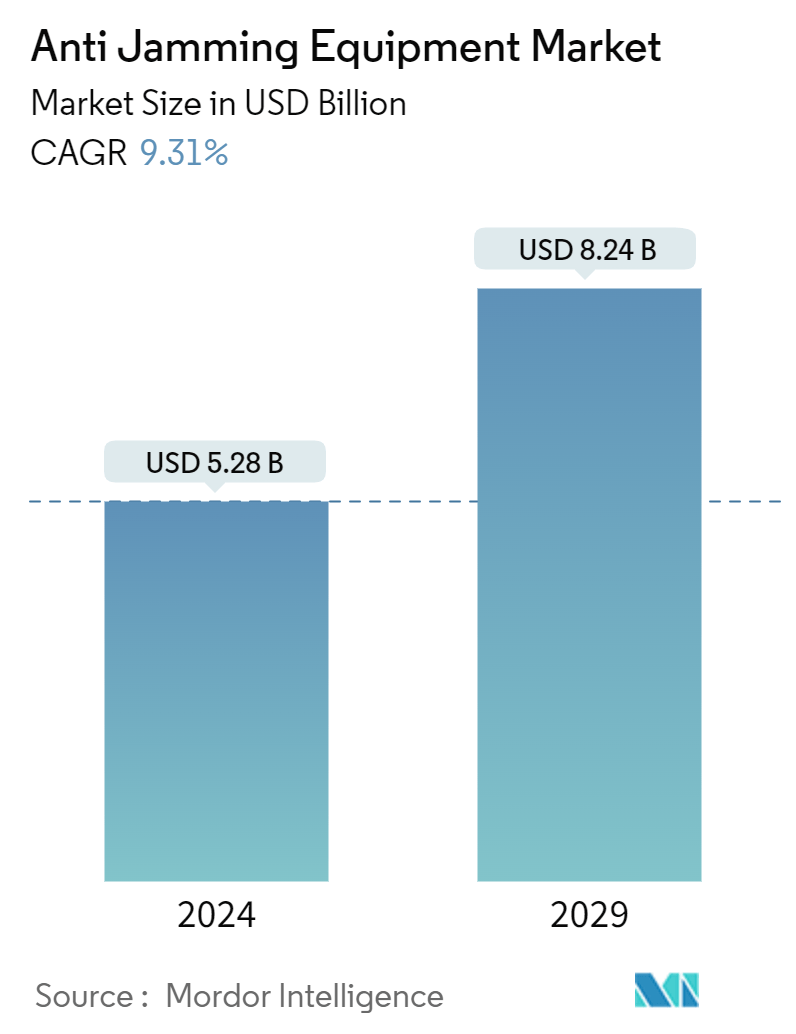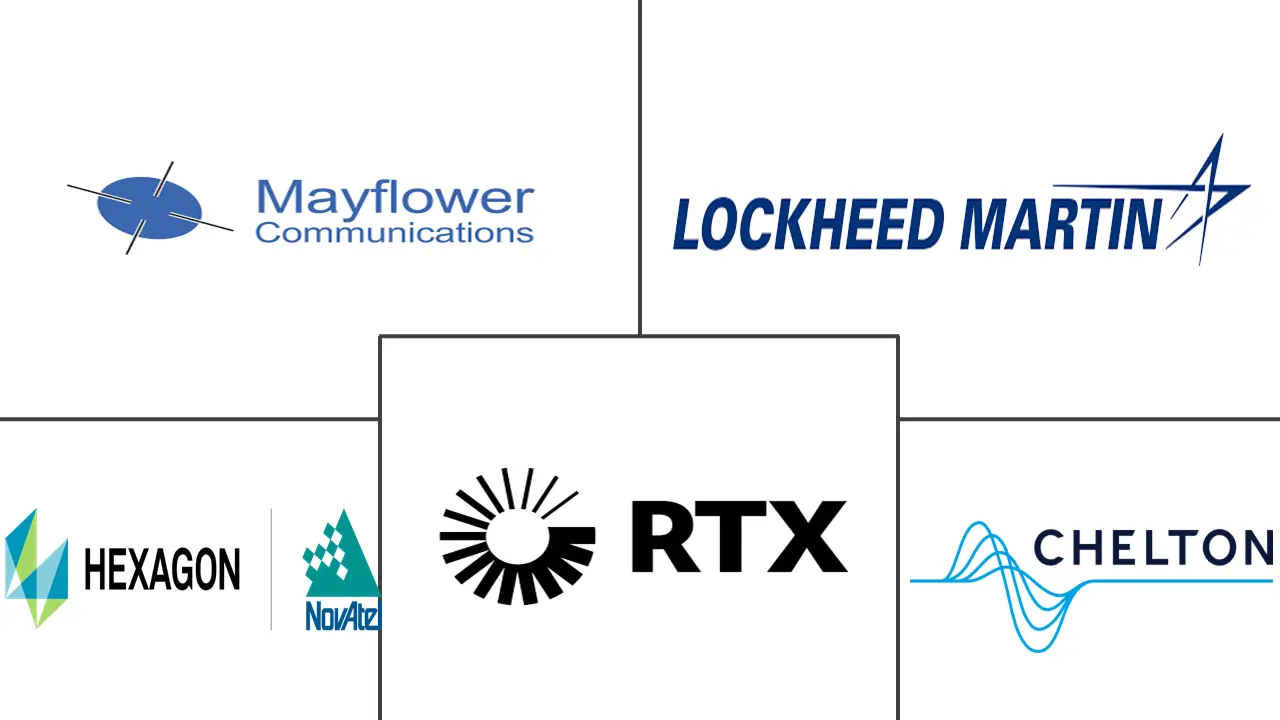Market Size of Anti Jamming Equipment Industry

| Study Period | 2019 - 2029 |
| Market Size (2024) | USD 5.28 Billion |
| Market Size (2029) | USD 8.24 Billion |
| CAGR (2024 - 2029) | 9.31 % |
| Fastest Growing Market | Asia Pacific |
| Largest Market | North America |
Major Players
*Disclaimer: Major Players sorted in no particular order |
Anti-Jamming Equipment Market Analysis
The Anti Jamming Equipment Market size is estimated at USD 5.28 billion in 2024, and is expected to reach USD 8.24 billion by 2029, growing at a CAGR of 9.31% during the forecast period (2024-2029).
Anti-jamming solutions are essential across a range of applications. Unmanned vehicles, automated robotic platforms, time synchronization systems, and various military vehicles face threats due to the challenges in receiving GNSS signals. The swift evolution of jammers, compounded by industrial noise, has heightened the demand for interference immunity to ensure reliable operations. This increased demand has led to significant advancements in anti-jamming technologies, which are now more sophisticated and effective than ever.
- Jamming can disrupt wireless transmissions, leading to denial of service (DOS), insertion of unwanted messages, original content corruption, and blocking critical messages, all while interfering with radio signals. The impact of jamming on communication systems can be severe, causing significant operational disruptions and potential security breaches. Therefore, developing and deploying robust anti-jamming solutions are crucial for maintaining the integrity and reliability of wireless communication networks.
- GPS technology is developing, focusing on miniaturization, weight reduction, and heightened accuracy. GPS satellites act as precise timekeepers, relaying both time and orbital data. A receiver pinpoints its Earth location by analyzing signals from at least three satellites.
- The increasing deployment of General Packet Radio Services (GPRS) infrastructure drives the demand for anti-jamming equipment, particularly in sectors reliant on secure and reliable communications. GPRS enhances data transfer capabilities for mobile networks, facilitating machine-to-machine (M2M) communication, IoT devices, and mobile internet access. As more devices connect, the potential for interference and jamming increases, particularly in critical applications like defense, transportation, and emergency services.
- The demand for fully autonomous drones is rising across industries, from agriculture and construction to search and rescue operations. These systems rely on continuous communication with GPS and ground stations. Jamming could cause a loss of control, making anti-jamming technology vital for safety and operational success. Further, the market is expected to benefit from the increased demand for unmanned airborne vehicles and systems and the development of low-cost GPS anti-jamming solutions during the forecast period.
- The complexity of manufacturing anti-jamming equipment poses several challenges that can restrain the market's growth. This complexity arises from the need to meet high performance, cost-effectiveness, and adaptability standards, especially in military, defense, and commercial applications.
Anti-Jamming Equipment Industry Segmentation
Anti-jamming equipment protects signal receivers from intervention and deliberate jamming. For instance, when a GPS signal reaches the earth's surface, it becomes weak and susceptive to being overcome by more powerful radio frequency (RF) energy. GPS anti-jamming handles power minimization to decrease the effect of interference and jamming so that the GPS receiver can continue to function correctly. The market's scope is limited to anti-jamming equipment offered by market vendors, which includes civilian and defense applications.
The anti-jamming equipment market is segmented by technology (nulling technique, civilian techniques, and beam steering techniques), end-user application (flight control, defense, surveillance and reconnaissance, navigation, position, timing, casualty evacuation, and other end-user applications), and geography (North America (United States, Canada), Europe (Germany, United Kingdom, France, rest of Europe), Asia-Pacific (China, Japan, South Korea, rest of Asia-Pacific) and rest of the World). The report offers market forecasts and size in value (USD) for all the above segments.
| Technology | |
| Nulling Technique | |
| Civilian Techniques | |
| Beam Steering Techniques |
| End-user Application | |
| Flight Control | |
| Defense | |
| Surveillance and Reconnaissance | |
| Navigation, Position, and Timing | |
| Casualty Evacuation | |
| Other End-user Applications |
| Geography*** | |||||
| |||||
| |||||
| |||||
| Australia and New Zealand | |||||
| Latin America | |||||
| Middle East and Africa |
Anti Jamming Equipment Market Size Summary
The anti-jamming equipment market is poised for significant growth, driven by the increasing need for reliable GNSS signal reception in various applications such as unmanned vehicles, automated robotic platforms, and military vehicles. The susceptibility of wireless networks to jamming attacks has underscored the importance of anti-jamming solutions to maintain continuous connectivity and service quality. Traditional anti-jamming technologies face challenges due to low spectral efficiency and the evolving complexity of jamming devices, prompting advancements in GPS technology and the development of more sophisticated anti-jamming solutions. The military sector, in particular, is heavily investing in modernizing aircraft and unmanned aerial vehicles with advanced positioning and navigation systems, highlighting the critical role of anti-jamming equipment in ensuring operational efficiency and mission success.
Regionally, the Asia-Pacific market is experiencing heightened demand for anti-jamming equipment, fueled by increased military expenditure and technological advancements. Countries like China and Japan are expanding their defense capabilities, with significant investments in anti-jamming solutions to enhance security and support their growing aviation industries. South Korea is also witnessing growth opportunities due to urbanization and industrialization, alongside military and civilian infrastructure development. The market is moderately competitive, with key players like BAE Systems, Collins Aerospace, and Raytheon Company leveraging strategic collaborations and technological innovations to capture market share and improve profitability. Recent developments, such as the introduction of next-generation GPS technology and strategic investments in anti-jamming startups, underscore the dynamic nature of the market and its potential for continued expansion.
Anti Jamming Equipment Market Size - Table of Contents
-
1. MARKET INSIGHTS
-
1.1 Market Overview
-
1.2 Industry Attractiveness - Porter's Five Forces Analysis
-
1.2.1 Bargaining Power of Suppliers
-
1.2.2 Bargaining Power of Buyers
-
1.2.3 Threat of New Entrants
-
1.2.4 Threat of Substitutes
-
1.2.5 Intensity of Competitive Rivalry
-
-
1.3 Industry Value Chain Analysis
-
1.4 Assessment of the Impact of Macroeconomic Factors on the Market
-
-
2. MARKET SEGMENTATION
-
2.1 Technology
-
2.1.1 Nulling Technique
-
2.1.2 Civilian Techniques
-
2.1.3 Beam Steering Techniques
-
-
2.2 End-user Application
-
2.2.1 Flight Control
-
2.2.2 Defense
-
2.2.3 Surveillance and Reconnaissance
-
2.2.4 Navigation, Position, and Timing
-
2.2.5 Casualty Evacuation
-
2.2.6 Other End-user Applications
-
-
2.3 Geography***
-
2.3.1 North America
-
2.3.1.1 United States
-
2.3.1.2 Canada
-
-
2.3.2 Europe
-
2.3.2.1 Germany
-
2.3.2.2 United Kingdom
-
2.3.2.3 France
-
-
2.3.3 Asia
-
2.3.3.1 China
-
2.3.3.2 Japan
-
2.3.3.3 South Korea
-
-
2.3.4 Australia and New Zealand
-
2.3.5 Latin America
-
2.3.6 Middle East and Africa
-
-
Anti Jamming Equipment Market Size FAQs
How big is the Anti Jamming Equipment Market?
The Anti Jamming Equipment Market size is expected to reach USD 5.28 billion in 2024 and grow at a CAGR of 9.31% to reach USD 8.24 billion by 2029.
What is the current Anti Jamming Equipment Market size?
In 2024, the Anti Jamming Equipment Market size is expected to reach USD 5.28 billion.

